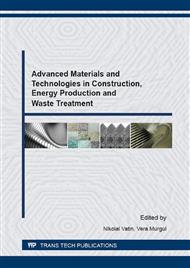[1]
Yu. Nikitin, V. Murgul, N. Vatin, V, Pukhkal. Uses of glass in architecture: heat losses of buildings based on translucent structures, Applied Mechanics and Materials. 680 (2014) 481-485.
DOI: 10.4028/www.scientific.net/amm.680.481
Google Scholar
[2]
D. Nemova, V. Murgul, A. Golik, E. Chizhov, V. Pukhkal, N. Vatin. Reconstruction of administrative buildings of the 70s: the possibility of energy modernization, Journal of Applied Engineering Science. 12 (2014) 37-44.
DOI: 10.5937/jaes12-5610
Google Scholar
[3]
V. Golovanov, V. Pavlov, A. Pekhotikov. Obespechenie ognestojkosti nesushchih stroitel'nyh konstrukcij [Fire resistance of supporting structures], Pozharnaya bezopasnost [Fire Safety]. 3 (2002) 48-58.
Google Scholar
[4]
V. Strakhov, A. Garashchenko, G. Kuznetsov, V. Rudzinskii. Matematicheskoe modelirovanie teplofizicheskih i termohimicheskih processov pri gorenii vspuchivayushchihsya ognezashchitnyh pokrytij [Mathematical modeling of thermal and thermo-chemical processes in combustion intumescent fire protective coatings], [Fizika goreniya i vzryva] Combustion, explosion, and shock waves. 2 (2001).
DOI: 10.1023/a:1017557726294
Google Scholar
[5]
M. Lazarevska, M. Cvetkovska, M. Knezevic, A. Trombeva Gavriloska, M. Milanovic, V. Murgul, N. Vatin. Neural Network Prognostic Model for Predicting the Fire Resistance of Eccentrically Loaded RC Columns, Applied Mechanics and Materials. 627 (2014).
DOI: 10.4028/www.scientific.net/amm.627.276
Google Scholar
[6]
M. Salminen, M. Heinisuo. Numerical analysis of thin steel plates loaded in shear at non-uniform elevated temperatures, Journal of Constructional Steel Research. 97 (2014) 105-113.
DOI: 10.1016/j.jcsr.2014.02.002
Google Scholar
[7]
National Standart 181-70. Ukazaniya po proektirovaniyu cvetovoj otdelki inter'erov proizvodstvennyh zdanij promyshlennyh predpriyatij [Design information color interior decoration industrial buildings industrial].
Google Scholar
[8]
National Standart 15548-70. Cveta signal'nye i znaki bezopasnosti dlya promyshlennyh predpriyatij [Colors signaling and safety signs for the industrial enterprises].
Google Scholar
[9]
National Standart 14202-69. Truboprovody promyshlennyh predpriyatij. Opoznavatel'naya okraska, preduprezhdayushchie znaki i markirovochnye shchitki [Pipelines industry. Identification color of the warning signs and marking plates].
Google Scholar
[10]
S. Christkea, A. Gibsona, K. Grigorioub, A. Mouritzb. Multi-layer polymer metal laminates for the fire protection of lightweight structures, Materials & Design. 97 (2016) 349-356.
DOI: 10.1016/j.matdes.2016.02.105
Google Scholar
[11]
O. Lamkin, M. Gravit, O. Nedryshkin. Experimental and theoretical research fire danger facade system «Technocom», Construction of Unique Buildings and Structures. 11(38) (2015) 42-58.
Google Scholar
[12]
N. Bezgin. An experimental evaluation to determine the required thickness of passive fire protection layer for high strength concrete tunnel segments, Construction and Building Materials. 97 (2015) 279–286.
DOI: 10.1016/j.conbuildmat.2015.07.130
Google Scholar
[13]
M. Gravit. Rasprostranenie rezul'tatov ispytanij na ognestojkost' svetoprozrachnyh ograzhdayushchih nenesushchih konstrukcij [Distribution of test results for fire resistance of translucent curtain walling designs], Pozharovzryvobezopasnost' [Fire and Explosion Safety]. 11 (2014).
Google Scholar
[14]
ETAG 018. ETAG 018. Guideline for European technical approval of fire protective products. Part 2: Reactive coatings for fire protection of steel elements.
Google Scholar
[15]
DD ENV 13381-4: 2002 Test methods for determining the contribution to the fire resistance of structural members. Applied protection to steel members.
DOI: 10.3403/02616125u
Google Scholar
[16]
DIN EN 13381-8 Test methods for determining the contribution to the fire resistance of structural members - Part 8: Applied reactive protection to steel members.
DOI: 10.3403/30256862
Google Scholar
[17]
W. Wang, G. Li. Fire-resistance study of restrained steel columns with partial damage to fire protection, Fire Safety Journal. 44 (2009) 1088–1094.
DOI: 10.1016/j.firesaf.2009.08.002
Google Scholar
[18]
M. Heinisuo, M. Laasonen, J. Outinen, J. Hietaniemi. Systematisation of design fire loads in an integrated fire design system, Application of Structural Fire Design. 1 (2011) 405-410.
Google Scholar
[19]
M. Gravit, V. Gumenyuk, O. Nedryshkin. Fire Resistance Parameters for Glazed Non-Load-Bearing Curtain Walling Structures. Extended Application, Procedia Engineering. 117 (2015) 114 – 118.
DOI: 10.1016/j.proeng.2015.08.131
Google Scholar
[20]
A. Krivtcov, V. Kazakova, I. Mingalimov, P. Bogdanov, I. Nitsa. Calculation of the most effective section of a steel column from the point of view of fire protection, Construction of Unique Buildings and Structures. 6 (33) (2015) 34-46.
Google Scholar
[21]
N. Vatin, A. Gorshkov, D. Nemova, A. Staritcyna, D. Tarasova. The energy-efficient heat insulation thickness for systems of hinged ventilated facades, Advanced Materials Research. 1 (2014) 941 – 944, 905-920.
DOI: 10.4028/www.scientific.net/amr.941-944.905
Google Scholar
[22]
Federal Law number 123. Tekhnicheskij reglament o trebovaniyah pozharnoj bezopasnosti [Technical Regulations on Fire Safety Requirements].
Google Scholar
[23]
R. Kostić, N. Vatin, V. Murgul. Fire Safeguards of Plastbau, Construction, Applied Mechanics and Materials. 725-726 (2015) 138-145.
DOI: 10.4028/www.scientific.net/amm.725-726.138
Google Scholar
[24]
P. Kraus, M. Mensinger, F. Tabeling, P. Schaumann. Experimental and Numerical Investigations of Steel Profiles with Intumescent Coating Adjacent to Space-Enclosing Elements in Fire, Journal of Structural Fire Engineering. 6 (2015) 237-246.
DOI: 10.1260/2040-2317.6.4.237
Google Scholar
[25]
K. Bzdawka, M. Heinisuo. Fin plate joint using component method of EN 1993-1-8, Rakenteiden Mekaniikka (Journal of Structural Mechanics). 43 (2010) 25-43.
Google Scholar
[26]
M. Sarraj, I. Burgess, J. Davison, R. Plank. Finite element modeling of steel fin plate connections in fire, Fire Safety Journal. 42 (2007) 408-415.
DOI: 10.1016/j.firesaf.2007.01.007
Google Scholar
[27]
H. Perttola, M. Heinisuo. 3D Component method for base bolt joint, Steel Structures: Culture & Sustainability 2010,. 2010, Istanbul.
Google Scholar
[28]
A. Korotkov. Melamine/monoammonium phosphate complex as the polyphosphate substitute in flame retardant coatings, Journal of Fire Sciences. 34 (2016) 89-103.
DOI: 10.1177/0734904115621583
Google Scholar
[29]
B. Kandola, M. Akonda, A. Horrocks. Fibre-reinforced glass/silicate composites: effect of fibrous reinforcement on intumescence behaviour of silicate matrices as a fire barrier application, Original Research Article Materials & Design. 86 (2015).
DOI: 10.1016/j.matdes.2015.07.103
Google Scholar
[30]
W. Zhang, X. He, T. Song, Q. Jiao, R. Yang. Comparison of intumescence mechanism and blowing-out effect in flame-retarded epoxy resins, Original Research Article Polymer Degradation and Stability. 112 (2015) 43-51.
DOI: 10.1016/j.polymdegradstab.2014.11.017
Google Scholar
[31]
O. Blaževica-Juhnevica, D. Serdjuks, R. Ozolins, V. Goremikins, L. Pakrastins. Choice of Rational Parameters of Combined Structure Original Research Article, Procedia Engineering. 117 (2015) 85-93.
DOI: 10.1016/j.proeng.2015.08.128
Google Scholar


